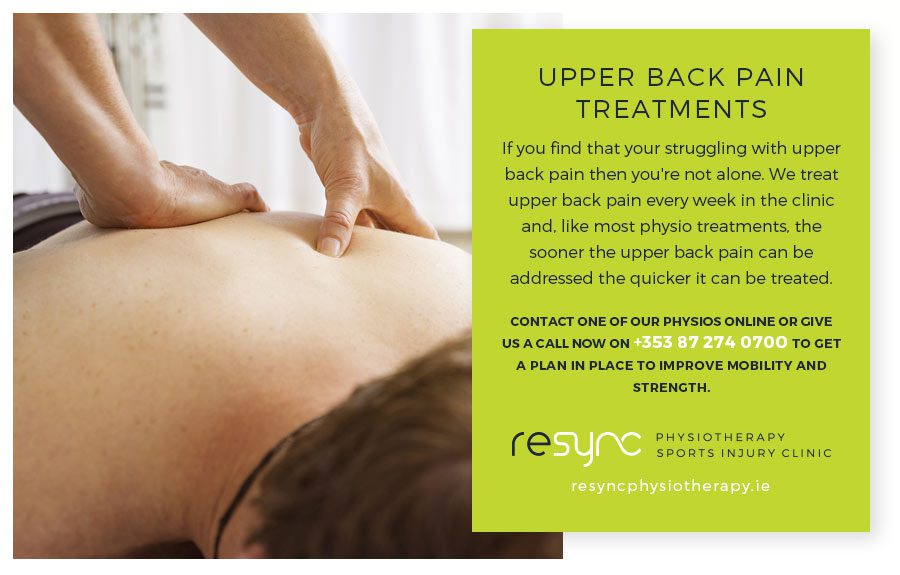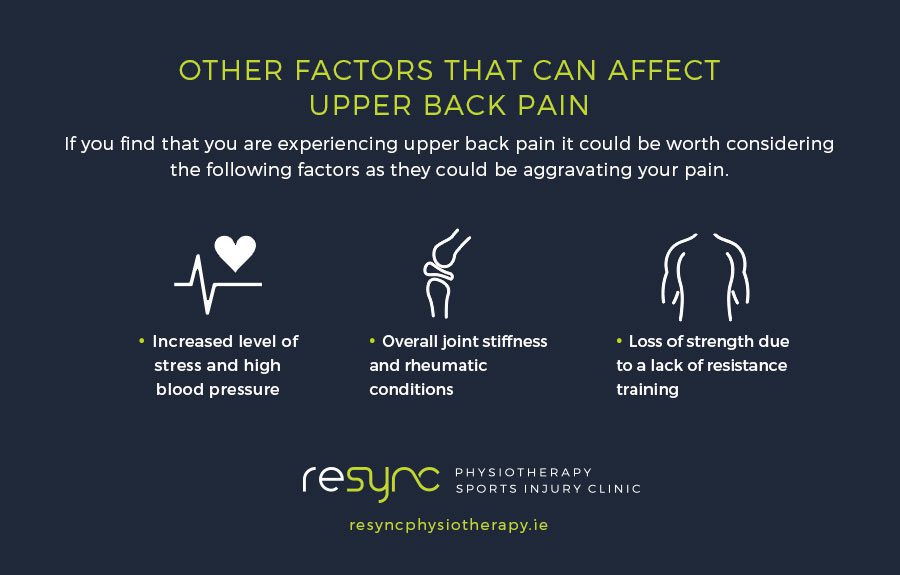Understanding and Treating Upper Back Pain: A Comprehensive Guide
Have you ever found yourself rubbing your upper back, wishing away a nagging ache that’s been troubling you throughout the day?
Maybe it’s that constant tension between your shoulder blades or a more debilitating pain that makes every twist and turn a trial. Either way, you’re not alone. Countless individuals worldwide experience the discomfort of upper back pain.
This guide aims to equip you with an understanding of this widespread issue, its causes, and how it’s identified, hoping to lead you toward a pain-free existence.
What is Upper Back Pain?
Upper back pain is discomfort or distress experienced in the area between the neck and the lower back, typically encompassing the area around your rib cage connected to your spine.
This region houses critical parts of your skeletal structure, such as the thoracic spine and shoulder blades, as well as numerous muscles and nerves.
The thoracic spine, unique due to its direct attachment to the rib cage, provides stability and protection rather than flexibility. Muscles in this region, like the trapezius and rhomboids, contribute to our ability to perform daily tasks, such as lifting and pulling.
These components’ interconnected nature means that an issue with one could significantly impact the others, often leading to upper back pain.

Types of Upper Back Pain
Upper back pain generally falls into two categories: joint dysfunction and muscular irritation. These can manifest due to various factors, and understanding them can help guide the right treatment strategy.
1. Joint Dysfunction
This typically arises due to a sudden injury, such as a fall or accident, or natural degeneration from aging. The joints in the upper back, known as costovertebral joints, connect the spine to the ribs, and any dysfunction in these joints can cause significant discomfort.
A sudden injury might strain or sprain these joints, leading to acute pain. On the other hand, wear and tear over the years due to aging can result in osteoarthritis, a degenerative condition characterized by chronic joint pain and stiffness.
2. Muscular Irritation
Also known as myofascial pain syndrome, muscular irritation in the upper back usually results from poor posture, repetitive strain, or psychological stress.
Due to these factors, our upper back muscles, including the trapezius and rhomboids, are susceptible to developing trigger points or tight knots. These trigger points can cause pain locally or refer to other areas, leading to a widespread sensation of discomfort.
Common Causes of Upper Back Pain
Here are the common causes:
- Postural Issues – The rise of desk jobs and digital dependency has ushered in a posture crisis. Slouching, hunching over keyboards, and craning necks to look at screens put unnatural pressure on the spine, leading to upper back pain.
- Muscular Strain and Tension – Repetitive motions, heavy lifting, or even carrying a weighty backpack can strain your upper back muscles. Stress also contributes to muscle tension, translating into a stubborn knot of discomfort in your upper back.
- Disc Issues – While less common in the thoracic spine, herniated or degenerated discs can cause chronic upper back pain. These conditions occur when the discs cushioning your vertebrae wear out or rupture.
- Injuries and Trauma – Accidents, sports-related injuries, or sudden movements can lead to sprains or fractures in the upper back, causing acute or chronic pain.
- Other Medical Conditions – Arthritis, osteoporosis, gallbladder issues, and certain lung diseases can manifest as upper back pain. Even conditions like heart disease can cause referred pain in the upper back.

Upper Back Pain Symptoms
Recognizing upper back pain involves more than just identifying an ache or discomfort. Here are some common symptoms associated with it:
- Persistent stiffness or tension in the upper back region
- Burning or sharp pain, especially when moving or lifting
- Chronic ache in the upper back, especially after long periods of sitting or standing
- Radiating pain in the neck, shoulders, and arms
- Tingling or numbness in limbs
- Difficulty in performing everyday tasks due to discomfort
- In severe cases, loss of bowel or bladder control (this warrants immediate medical attention)
By understanding these aspects of upper back pain, we can better equip ourselves to seek appropriate treatment and care, moving towards a pain-free life.
Diagnosis of Upper Back Pain
Finding yourself wincing as you reach the top shelf or feeling constant nagging pain in your upper back is far from a pleasant experience.
Sometimes, we choose to soldier on, attributing the discomfort to poor sleep or a temporary muscle strain. But when should we take it seriously and seek professional help?
When to See a Doctor?
Deciding when to see a doctor about your upper back pain can be tricky. While it’s not ideal for rushing to the clinic for every minor ache, certain signals should prompt you to seek medical attention:
- The pain is severe or persistent, lasting over a few weeks despite home remedies and rest.
- You experience numbness, weakness, or tingling in your arms or legs.
- Your pain is accompanied by unexplained weight loss, fever, or chills.
- The pain spreads down your legs or arms or up to your neck.
- It disturbs your sleep or affects your daily activities.
When in doubt, it’s always better to err on caution. A healthcare professional can provide the correct diagnosis and steer your recovery in the right direction.
Typical Diagnostic Procedures
So, you’ve decided to see a doctor. What should you expect during your visit? The diagnostic process typically involves a mix of the following procedures:
1. Physical Examination
This usually involves the doctor asking about your symptoms, medical history, and specific incidents that might have triggered the pain. They may also perform a physical exam, checking for pain points, range of motion, and any signs of nerve damage.
2. Imaging Tests
If the cause of your pain is not evident from the physical exam, your doctor might order imaging tests. These could include X-rays for fractures or arthritis, MRIs to detect issues with discs or nerves, or CT scans for a detailed spine view.
3. Other Diagnostic Tests
In some cases, other tests may be necessary. For instance, nerve studies like electromyography (EMG) can help identify nerve compression caused by herniated disks or spinal stenosis. Blood tests might be conducted to rule out infection or inflammatory conditions.
Non-Surgical Treatments for Upper Back Pain
Dealing with upper back pain does not always mean going under the knife. Many non-surgical treatments can provide significant pain relief and improve your quality of life. These treatments range from lifestyle changes to physical therapy and even complementary therapies.
Lifestyle Changes
1. Posture Improvement
Poor posture is one of the leading culprits of upper back pain. By consciously maintaining good posture, especially when sitting for extended periods or using digital devices, you can significantly reduce upper back discomfort.
Keep your back straight and shoulders relaxed, and ensure your workspace is set up ergonomically to support your posture.
2. Ergonomic Adjustments at Work and Home
A well-set workspace that reduces strain on your upper back can help manage pain. Opt for a chair that supports the natural curve of your spine, keep your computer screen at eye level, and take regular breaks to move and stretch.
Similarly, maintain good posture at home while lifting heavy objects or performing household chores.
Physical Therapy and Exercise
Types of Exercises Beneficial for Upper Back Pain
Specific exercises can help strengthen your large upper back muscles, improve flexibility, and reduce pain. These can include:
- Stretches
- Low-impact aerobics
- Strengthening exercises
Activities like yoga and Pilates, which encourage core stability and flexibility, can also be beneficial.
Role of a Physical Therapist
A physical therapist can provide a personalised exercise regimen based on your unique needs and pain points. They can guide you on the correct techniques, ensure you are not exacerbating the issue, and monitor your progress over time.
Complementary Therapies
1. Massage
A good massage can alleviate muscle tension, improve circulation, and provide instant relief from upper back pain. A professional therapist will know exactly where to apply pressure and how to soothe your aching muscles.
2. Acupuncture
Acupuncture, a traditional Chinese medicine technique, involves inserting thin needles into specific points on the body. Many people have found it effective for managing back pain.
3. Chiropractic Treatments
Chiropractors use hands-on spinal manipulation and other alternative treatments to enable the body to heal itself without surgery or medication. This method can be effective in relieving pain and improving function.
Surgical Treatments for Upper Back Pain
Sometimes, non-surgical treatments might not provide the relief needed, and surgery becomes an option.
Surgery is generally considered when the pain is severe, pain persists for an extended period, and is accompanied by other serious symptoms like nerve damage.
The decision is significant and should be taken after a comprehensive discussion with your healthcare provider.
Common Types of Surgery for Upper Back Pain
Common surgical procedures for upper back pain include:
- Discectomy – Removal of a herniated disc.
- Laminectomy – Removal of the bony arch of a vertebra to relieve pressure on the spinal cord.
- Spinal fusion – Joining two or more vertebrae together to stabilize the spine.
The choice of procedure will depend on your specific condition.
Risks and Benefits of Surgery
Like any surgical procedure, these come with risks and potential complications like:
- Infection
- Blood clots
- Nerve damage
- Adverse reactions to anesthesia
However, when successful, surgery can provide long-lasting relief and improve quality of life. The decision should balance the potential risks and benefits and consider the patient’s overall health, pain severity, and response to non-surgical treatments.
Remember, each person’s journey with upper back pain is unique, and what works for one might not work for another. It’s crucial to stay proactive, informed, and open in conversations with your healthcare provider.
Conclusion
Navigating upper back pain can be challenging, but gaining insights into its causes, diagnosis, and treatment options is a significant step toward relief.
Remember, your experience is unique, and consulting with a healthcare professional for personalised advice is crucial.
With the right approach, a pain-free life isn’t just a dream—it’s a real and achievable goal. We hope this article has helped.
Thanks for reading!



